Mastering the Art of Informative Blog Writing: Demystifying “PBT in Finance
5 min read
Are you ready to dive into the world of finance and unravel the secrets behind “PBT”? 🤔📚 Look no further! In this blog post, we will guide you through the art of informative blog writing as we demystify one of finance’s most puzzling concepts – “PBT”. 💼💡 Get ready to unravel its meaning, importance, and practical implications in a way that both engaging and easy to understand. Whether you’re a financial enthusiast or just starting out on your journey in understanding complex financial terms, this post here to make PBT crystal clear. So grab your favorite cup of coffee ☕️ and get ready for an enlightening exploration into mastering the art of informative blog writing with our focus on “PBT in Finance.” Let’s dig in! 💪😊
Introduction to PBT in Finance
If you’re working in finance or considering a career in the industry, it’s important to have a basic understanding of key financial concepts and terms. In this blog post, we’ll demystify one such term – “PBT.”
PBT stands for “profit before tax.” It’s a measure of a company’s profitability that includes all income and expenses before taxes are paid. This metric often used to evaluate a company’s performance over time or compare it to other businesses in its industry.
While PBT a useful metric, it’s important to remember that it doesn’t take into account all the factors that can affect a company’s bottom line. For example, PBT doesn’t consider the effect of taxes on profits. As such, it should be used as one piece of information when making investment decisions.
What is PBT?
PBT, or Profit Before Tax, a financial metric that measures a company’s profitability before taxes are taken into account. This metric often used to compare a company’s profitability with that of its competitors.
PBT calculated by subtracting a company’s total expenses from its total revenues. This number can then be compared to the company’s tax bill to determine its true profit after taxes.
PBT an important metric for investors to consider when evaluating a company, as it can give them a better idea of the company’s bottom line. It also important for managers to keep track of, as it can help them make decisions about where to allocate resources.
Benefits of PBT in Finance
In recent years, PBT (Prestige Banking Technology) has become increasingly popular in the finance industry. PBT a cutting-edge banking technology that offers a number of benefits for both financial institutions and their customers. Here are some of the key benefits of PBT in finance:
1. Increased security: PBT employs the latest security technologies to protect both financial institutions and their customers from fraud and cybercrime.
2. Faster transactions: PBT enables faster transactions between financial institutions and their customers, which can save time and money.
3. Improved customer service: PBT’s features and functionality can help financial institutions improve their customer service levels.
4. Reduced costs: PBT can help financial institutions reduce their operating costs by streamlining processes and improving efficiencies.
5. increased revenues: By offering a better overall experience to customers, PBT can help financial institutions increase their revenues.
How Does PBT Work?
The PBT method, otherwise known as the present-based taxation system, works by imposing taxes on individuals and organizations based on their current economic situation. The goal of this system to encourage businesses to invest and grow, while at the same time collecting revenues for government expenditures. To calculate PBT, tax experts take into account an individual’s or organization’s current assets, liabilities, and cash flow. This information is then used to determine the amount of taxes owed.
Different Types of PBT
Different types of PBT exist, each with its own unique benefits. The most common type of PBT is called “profit before taxes.” This type of PBT includes all forms of income and expenses incurred during the course of business operations, including interest expense, depreciation, amortization, and other one-time items.
Another popular type of PBT is “revenue before taxes.” This metric focuses solely on revenue generated by the company’s core business activities. This provides a more accurate picture of the company’s performance since it excludes items that are not directly related to business operations.
There is “operating profit before taxes.” This is the most conservative measure of PBT since it only includes income and expenses related to day-to-day operations. This metric is often used to assess the profitability of a company’s core business activities.
Challenges of PBT
PBT, or Profit Before Tax, is one of the most important financial measures used by businesses to determine their bottom line. However, PBT can be challenging to calculate accurately for a number of reasons.
First, PBT excludes certain items that can have a significant impact on profitability, such as depreciation and amortization. This can make it difficult to get an accurate picture of true profits.
Second, businesses must carefully consider how to allocate expenses between different tax brackets. This can be a complex process, and mistakes can easily lead to over- or under-estimating profits.
PBT is heavily reliant on accurate revenue forecasts. If revenue estimates are off, even by a small amount, it can have a major impact on PBT. Businesses must therefore be very careful in their forecasting methods and assumptions to ensure that they are not underestimating or overestimating their potential profits.
Interested in More Information About PBT?
If you’re reading this article, it’s likely that you’re already somewhat familiar with PBT (Profit Before Tax). But just in case you’re not, let’s start with a brief overview.
PBT is a measure of a company’s profitability that includes all income and expenses before taxes are levied. In other words, it’s a way to assess how profitable a company would be if it didn’t have to pay any taxes.
There are a few key things to keep in mind when considering PBT. First, it’s important to remember that PBT is only one metric of many that can be used to assess a company’s financial health. Second, PBT can be affected by one-time items or non-recurring expenses, so it’s important to take those into account when looking at PBT figures. While PBT is helpful in assessing profitability, it doesn’t give the full picture of a company’s financial situation – for that, you’ll need to look at other measures like net income and cash flow.
Now that we’ve cleared up what PBT is and why it matters, let’s take a closer look at how it’s calculated.
Conclusion
In conclusion, learning the art of informative blog writing and understanding what PBT in finance is can be a great asset in your career. With good research skills and an eye for detail, you will have no problem coming up with topics to write about and delivering quality content that resonates with readers. Keep honing your blogging skills by practicing as often as you can and protecting yourself against copyright issues by using sources wisely – it’ll all benefit you in the end. Good luck!
Get to Know More about Profit Before Tax (PBT).



